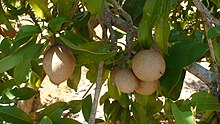|
Manilkara
Manilkara is a genus of trees in the family Sapotaceae. They are widespread in tropical and semitropical locations, in Africa, Madagascar, Asia, Australia, and Latin America, as well as various islands in the Pacific and in the Caribbean.[4] A close relative is the genus Pouteria. Trees of this genus yield edible fruit, useful wood, and latex. The best-known species are M. bidentata (balatá), M. chicle (chicle) and M. zapota (sapodilla). M. hexandra is the floral emblem of Prachuap Khiri Khan Province in Thailand, where it is known as rayan. M. obovata shares the vernacular name of African pear with another completely different species, Dacryodes edulis, and neither should be confused with Baillonella toxisperma, known by the very similar name, African pearwood. Manilkara trees are often significant, or even dominant species in their native ecosystems, such as East Deccan dry evergreen forests, Central American premontane tropical wet forests, or together with Cynometra, in the Arabuko Sokoke National Park. Manilkara fruit are an important food item for various frugivores, in particular birds. The red fruit bat (Stenoderma rufum) is the primary – and possibly the only – seed disperser of M. bidentata in parts of the Caribbean. Tuckerella xiamenensis, a species of peacock mite, was described from a sapodilla tree. TaxonomyThe generic name, Manilkara, is derived from the Malayalam word manil-kara, a vernacular name for M. kauki; it combines Manil from Manilha, the Portuguese name of Manila in the Philippines, and kara meaning "fruit".[5]: 36 SpeciesSpecies accepted by Plants of the World Online as of December 2022:[6]
Several species are endangered due to overexploitation and habitat destruction. M. gonavensis of Haiti and M. spectabilis of Costa Rica are almost extinct.  References
|
||||||||||||||||||||||||||||||||||
